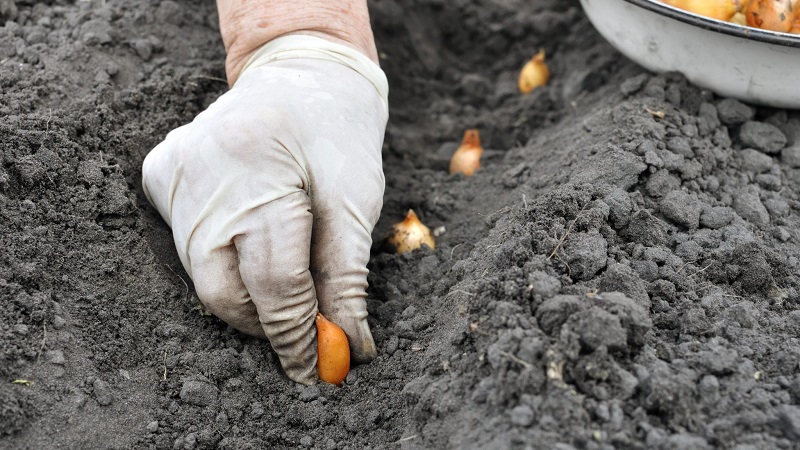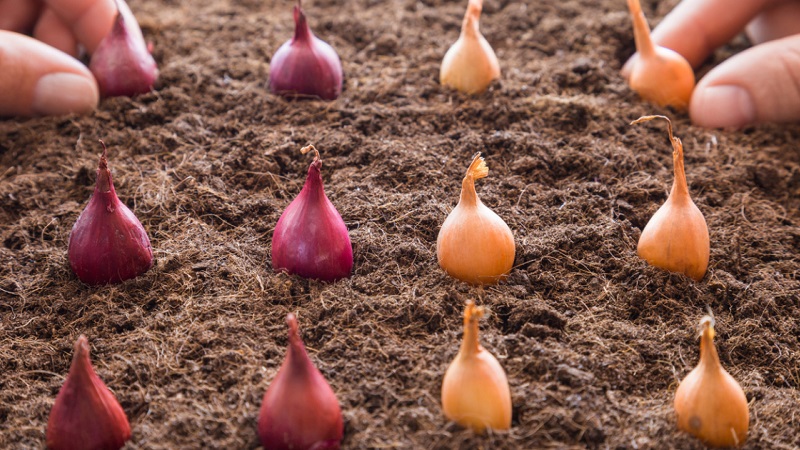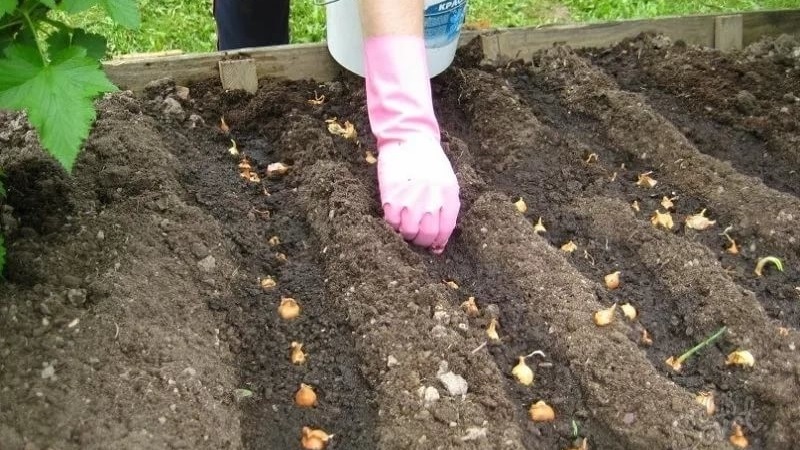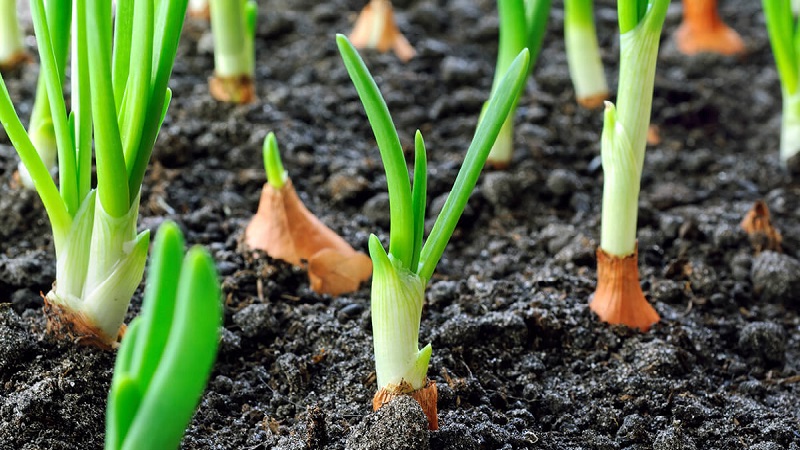Rules for planting onions on a turnip before winter
Onions are a vegetable crop grown in all regions of our country. Many summer residents prefer to plant onions in the spring, for fear of freezing of the planting material in the winter. But experienced gardeners use sevka planting before winter, noting the excellent characteristics of vegetables harvested in mid-summer.
In the article we will tell you whether it is possible to plant onions before winter, how to do it, and share the advice of experienced gardeners.
The content of the article
- Benefits of autumn winter planting onions on turnips
- When is it better to plant onions on a turnip: in autumn or spring
- What varieties are suitable for such a planting
- Seed preparation
- Soil preparation
- How to plant onions on a turnip before winter: scheme and planting rules
- Features of growing and care
- Do I need to cover plantings for the winter
- What problems can arise when growing
- Tips and tricks from experienced gardeners
- Conclusion
Benefits of autumn winter planting onions on turnips
Winter planting of onions has a lot of advantages.:
- The ripening period of winter onions is 25-30 days less than that of those planted in spring. Vegetables are harvested already in July.
- Early ripening vegetables, dill, parsley, lettuce are planted on the plot freed from onion plantations in the middle of summer.
- The first shoots of onions appear immediately after the snow melts, the greens rich in vitamins are cut in early spring.
- Winter onions that have endured cold weather are more resistant to diseases.
- Onions sprouting in early spring have more time for turnip growth.
- Small seedlings are difficult to preserve until spring; they dry out during the winter period. This problem is avoided by applying an autumn planting of seed. In the ground, small bulbs will be well preserved, in early spring they will sprout together, and a full-fledged bulb will grow from a small seed.
- Winter onions successfully resist damage by onion flies. The pest insect is activated in the spring. By this time, the onions are already gaining strength and growth in order to resist the invasion of the pest, while the fragile, delicate feathers of spring plantations serve as a good breeding ground for onion flies.
- After planting a crop before winter, farmers devote more time to other spring work.
- The economic side of the issue is also of great importance. The cost of the first harvest of onions is several times higher than the cost of last year.

When is it better to plant onions on a turnip: in autumn or spring
Many gardeners prefer to plant crops in the fall. They point out that turnips of winter onions are superior in size to those grown during spring planting.
Dates of autumn and spring planting
Planting time depends on the climatic conditions of the region, therefore, the timing is different in different areas.
The main condition for the beginning of winter planting of culture - steady decrease in temperature to + 5 ° С. It will take at least 3 weeks for the seed to take root. Therefore, sowing work is completed a month before persistent frosts.
Onions planted ahead of schedule can sprout in the fall. If the planting time is delayed, the bulbs will not have time to take root and will die.
In the central regions vegetables are planted before the end of October, in Siberia and the Urals planting work is completed in the middle of the month. In the southern regions, the crop is planted in mid-November.
Spring planting sevka is carried out late April - early May. They are waiting for the threat of night frosts to disappear, the soil warms up to + 12 ° C ... + 13 ° C.
What varieties are suitable for such a planting
For growing winter onions choose varieties:
- with high frost resistance;
- strong immunity to diseases;
- resistant to arrow formation.

The best winter varieties are considered:
- Arzamas - mid-season cold-resistant variety. Suitable for cultivation in the Urals, Siberia. It is characterized by a very pungent taste and high keeping quality. It is often affected by downy mildew, onion fly.
- Ellan - an early ripe variety. Greens on a feather are received in April. Seedlings tolerate temperatures down to -2 ° C well. It is characterized by excellent seed germination - 85-90%. The main advantage of the variety is the growth of a turnip in short daylight conditions.
- Radar - frost-resistant variety. With a high layer of snow cover, it can withstand temperatures down to -22 ° C, in the absence of snow - down to -15 ° C. The variety is not prone to shooting. Differs in high resistance to diseases and insect pests. It is characterized by large turnips weighing 130-200 g.
- Senshui - an early ripe variety. Feathers are harvested in early spring. It tolerates long-term temperature drop to -5 ° С and short-term down to -20 ° С. Differs in high productivity, resistance to shooting.
- Strigunovsky - an early ripe variety, gives high yields in the northern regions. Easily tolerates temperature changes. The variety is small, it grows 2 heads from 1 set. It is characterized by excellent maturation of turnips - 70-98%
- Shakespeare - early maturing frost-resistant variety. Thanks to its dense, hard skin, it can withstand temperatures as low as -18 ° C without snow cover. The variety is resistant to shooting and crop diseases. Poorly resistant to onion fly damage. It has a short shelf life - up to 6 months.
For winter cultivation, they prefer varietiesripening under conditions of short daylight hours (10-12 hours).
It is believed that it is better to plant varieties with a pungent taste before winter. Sweet onions do not tolerate frost well; they are best grown in the southern regions.
Seed preparation
Before planting in winter, the seed carefully prepare... First, good bulbs are selected, discarding damaged, sick ones. Then, calibration is carried out to obtain friendly shoots.
Unlike spring preparation, before winter sowing, the necks of the seeding are not cut off., the planting material is not soaked or germinated. Wet seedlings will immediately freeze out at the first frost.

How to prepare the onions
After deleting unusable copies calibrate the planting material, laying out the bulbs, depending on the size, into 3 piles.
In the first, bulbs with a diameter of up to 1 cm are selected - wild oats, they are grown for a turnip. In the second, a set is laid - onions with a diameter of 1-2 cm. It is grown on a feather and a turnip. Heads with a diameter of 2-3 cm are used to obtain early greens.
Reference! The larger the size of the planting material, the more powerful the feather grows.
Onions selected for winter planting are disinfected... To do this, the seed is soaked for 15-20 minutes in a solution of potassium permanganate or copper sulfate, after which it must be dried for at least 24 hours.
Since soaking in a disinfecting solution can provoke feather growth immediately after planting, apply heating of the planting material. This method inhibits the premature germination of vegetables. To do this, immediately before disembarking, they are immersed in hot water at a temperature of 80 ° C for 2-3 seconds.
Soil preparation
For planting crops choose a well-lit area... It should not be located in a lowland; when the snow melts, moisture will stagnate in such places, which will have a detrimental effect on the culture.
The soil in the beds should be loose, fertile... The culture responds well to drained, loamy soils. It grows poorly on heavy, clayey crops, and yields will be low. If there is soil with overestimated acidity on the site, dolomite flour and charcoal are added to it when digging.
One week before disembarkation sowing the soil is dug up with the introduction of humus (5 l / m²), ammophoska (20g / m²).
Reference! For podzimney planting, fresh manure is not used.
Predecessors
When planting onions, it is important to observe crop rotation rules. Best predecessors - potatoes, cucumbers, carrots, tomatoes, cabbage, lettuce, pumpkin, legumes. It is not recommended to plant a crop after garlic, sunflower, corn, parsley.
Re-planting of onions in the second year is allowed, but after that it is not recommended to plant it on this site for 3-4 years.
How to plant onions on a turnip before winter: scheme and planting rules
For planting onions in autumn and spring, the same schemes are used.
Oat planted to a depth of no more than 3 cm... Seeds embedded in the ground at a distance of 5-6 cm if the culture is grown on a feather, and after 9-10 cm to obtain a turnip.

A row spacing of 23-28 cm is left between the beds... The sevok is laid vertically in the grooves, covered with a layer of soil, slightly pressed. The beds are leveled, smoothing the grooves so that water does not stagnate in these places.
The culture is planted in dry weather... The soil should be slightly damp, not wet. When planting, make sure that the neck of the bulbs does not rise above ground level. There should be a layer of soil at least 1.5-2 cm above the seed.
Attention! When planting in winter, the beds with onions are not watered.
Features of growing and care
In winter, onion plantings do not require special care, except for shelter... Onions planted in the fall are not watered as the rainy season begins at this time. This allows the seed to take root well before frost. In winter, the culture is dormant. Gardening begins with the onset of spring.
Important! In spring, mulch is removed on time to provide access to sunlight for onion plantations. Small mulch is left, during loosening it is saturated with it.
Loosening and thinning
After each precipitation and after irrigation, the soil is loosened... This prevents the formation of a soil crust and provides air access to the onion roots.
During loosening, weeds are removed that prevent the full growth of the turnip. As the seedlings grow, thinned onion plantings are thinned out. Removed shoots are an excellent addition to vitamin salads.
Top dressing
In the spring, after the snow melts, a layer of mulch is removed from the beds and the first feeding is carried out wood ash, sprinkling it on the beds at the rate of 15 g / m². During the growth of feathers, turnip formation begins. During this period, feed with chicken droppings is carried out. To prepare the solution, it is mixed with water in a ratio of 1:20, insisted for 10-14 days. The resulting composition is diluted in a ratio of 1:20, applied at the root. After that, watered with clean water.
Organics alternate with mineral fertilizers, using a solution of ammophoska (20-25 g / m²) or urea (15 g / m²), superphosphate (30 g / m²). During the growth of turnips, potassium sulfate is used (15-20 g / m²).

Watering
If during the winter there was heavy rainfall in the form of snow, in the spring you can not rush to watering in order to prevent excessive soil moisture. They are also deposited during rainy weather in the spring. With the onset of warmth, onion beds are watered once a week. In a dry season, the frequency of watering is increased to 2 times a week.
Attention! From mid-May to mid-June, onions need abundant watering.
Protection from pests and diseases
Onion plantings infect various pests and diseases:
- Onion fly - especially prefers young shoots. Lays eggs between onion neck scales. The preparation "Zemlin", which is scattered over the soil surface, fights well against insects.
- Onion moth - eats away the flesh of feathers. They fight it with a solution of ammonia: 30 ml / 10 l of water. Infusions of tansy, wormwood, and tomato tops are also effective.
- Onion weevil - completely eats up the green mass. To scare it away, they use wood ash, tobacco.
- Onion feathers may appear powdery mildew... Its appearance is facilitated by thickened plantings, waterlogging of the beds. When growing a culture for a turnip, it is allowed to process green mass with "Topaz", 1% copper sulfate. When loosening the soil, crushed chalk and ash are scattered over the surface of the soil.
- Rust - appears as rusty brown fluffy formations on feathers. To prevent the disease, the soil is treated with a saturated pink solution of potassium permanganate before planting.
- Fusarium (bottom rot) - feathers turn yellow, dry out. Turnips stop growing, the roots and bottom turn black, the scales secrete mucus. For prophylaxis, seedlings are treated with a solution of "Fundazol". Watering with solutions of biofungicides "Trichodermin", "Maxim", "Previkur" is carried out 2 times a month.
Do I need to cover plantings for the winter
To avoid freezing of the seedlings during severe frosts, the beds are covered with a layer of mulchconsisting of sawdust, pine needles, peat. In the northern regions, to strengthen the shelter, a layer of straw and spruce branches is laid on top of the mulch.
This is especially important in the absence of snow cover, which protects the beds from freezing. In the presence of snow, a snow cover is specially created over the beds. Additional cover is not required in the southern areas.
Important! It is not recommended to cover onion plantings long before the onset of frost. Early warming will provoke the premature appearance of a young feather.
What problems can arise when growing
Considering the possible freezing of the bulbs during severe soil freezing, increase the amount of seed by 20%.

Some gardeners, in order to avoid freezing of the seedlings, deeply deepen the bulbs when planting. This leads to a delay in the emergence of seedlings., since it is difficult for tender sprouts to break through a thick layer of soil.
Many summer residents, fearing the early formation of a feather before the onset of frost, plant sevok at the end of November. Late planted small onions do not have time to take root until the soil freezes and die.
The beds that are not covered with mulch for the winter quickly freeze... Frequent, abundant watering leads to rotting of the onion heads.
If the beds are placed in shady areas, the turnips will grow small.
Tips and tricks from experienced gardeners
Experienced gardeners advise:
- Before planting, immerse the bulbs for 3 seconds in water heated to + 90 ° C. This will reduce the risk of fungal infections, protect the planting from the formation of arrows.
- With the onset of spring, remove the mulch from the beds as early as possible and start the first feeding.
- Spread or plant wormwood and tansy between the beds. The smell of these plants repels insect pests.
Conclusion
Planting onions on a turnip before winter differs slightly from planting in spring. If you follow the technology of growing crops, you can get a large harvest of onions 2 weeks earlier than with the spring planting of seedlings.
There is nothing difficult in growing winter onions, the main thing is to pay attention to the correct preparation of the planting material.